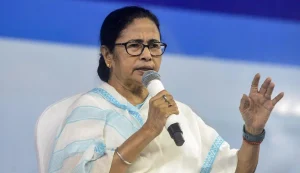West Bengal – The West Bengal assembly witnessed unprecedented Bengal Assembly Chaos on Thursday as ruling TMC and opposition BJP MLAs engaged in fierce confrontations that completely disrupted legislative proceedings. The dramatic scenes unfolded during discussions on a government resolution addressing alleged atrocities against Bengali migrants, transforming the session into a battleground of political accusations and counter-accusations.
The Bengal Assembly Chaos reached such intensity that assembly marshals were forced to intervene physically, creating unprecedented scenes in the state legislature that highlighted the deep political divisions affecting West Bengal’s governance.
Chief Minister’s Address Triggers Massive Uproar

The Bengal Assembly Chaos erupted precisely as Chief Minister Mamata Banerjee prepared to address the assembly on the Bengali migrants resolution. BJP legislators immediately began raising slogans, questioning the controversial suspension of Leader of the Opposition Suvendu Adhikari on September 2, which had already created significant political tension.
The timing of this Bengal Assembly Chaos appeared deliberately calculated to prevent the Chief Minister from presenting her government’s position on the sensitive migrant issue, escalating political tensions to unprecedented levels within the legislative chamber.
Speaker Responds with Immediate Suspensions
Amid the escalating Bengal Assembly Chaos, Speaker Biman Banerjee took decisive action by suspending BJP chief whip Shankar Ghosh from the assembly for the remainder of the day. The Speaker cited Ghosh’s role in creating disorder as justification for this disciplinary measure.
However, the Bengal Assembly Chaos intensified when Ghosh refused to leave voluntarily, necessitating the unprecedented step of calling assembly marshals to physically remove him from the House, creating dramatic visuals that underscored the severity of the political confrontation.
Physical Intervention Prevents Escalation

As the Bengal Assembly Chaos continued escalating with both sides engaging in heated verbal exchanges, assembly marshals positioned themselves strategically between the opposing groups to prevent potential physical altercations. The temperature in the House reached dangerous levels as political rhetoric transformed into increasingly aggressive confrontations.
The necessity for marshal intervention during this Bengal Assembly Chaos demonstrated how political discourse had deteriorated beyond normal parliamentary boundaries, requiring security measures typically reserved for maintaining public order.
Additional Suspensions Follow Continued Disruption
The Bengal Assembly Chaos expanded further when BJP MLA Agnimitra Paul was also suspended for persistently shouting slogans despite warnings from the Speaker. The disciplinary action required women marshals to escort Paul from the legislative chamber, highlighting the comprehensive breakdown of parliamentary decorum.
These multiple suspensions during the Bengal Assembly Chaos reflected the Speaker’s determination to restore order while simultaneously demonstrating the opposition’s commitment to disrupting proceedings regardless of consequences.
Allegations of Physical Confrontation
During the height of the Bengal Assembly Chaos, BJP legislators alleged that water bottles were thrown at them from the treasury benches, suggesting that the confrontation had moved beyond verbal exchanges toward potential physical altercations. These allegations added another dimension to an already volatile situation.
The water bottle throwing allegations during the Bengal Assembly Chaos raised serious questions about the deterioration of political civility and the need for enhanced security measures to protect legislators from all parties during contentious debates.
Historical Context of Political Tensions


The Bengal Assembly Chaos occurred against the backdrop of ongoing political tensions following Suvendu Adhikari’s suspension earlier in the week. This prior disciplinary action had created an atmosphere of resentment among opposition legislators, contributing to Thursday’s explosive confrontation.
Also Read: Largest Container Terminal: Revolutionary JNPA Expansion Unveiled by PM Modi
The connection between Adhikari’s suspension and Thursday’s Bengal Assembly Chaos demonstrates how individual disciplinary actions can escalate into broader institutional crises affecting the entire legislative process and democratic governance.
Impact on Legislative Business
The Bengal Assembly Chaos completely derailed the scheduled discussion on the government resolution addressing alleged atrocities against Bengali migrants, a serious issue requiring thoughtful legislative attention. The disruption prevented meaningful debate on matters affecting vulnerable communities.
This disruption of substantive legislative business due to Bengal Assembly Chaos highlights how political confrontations can undermine the assembly’s fundamental responsibility to address citizens’ concerns through reasoned debate and appropriate policy responses.
Broader Implications for Democratic Governance
The unprecedented scenes during this Bengal Assembly Chaos raise fundamental questions about the state of democratic discourse in West Bengal’s legislature. The requirement for marshal intervention and multiple suspensions suggests institutional mechanisms are struggling to contain political tensions.
The severity of this Bengal Assembly Chaos incident may necessitate review of assembly procedures and security protocols to prevent future disruptions while maintaining the democratic right of opposition parties to express dissent through appropriate parliamentary channels.
Moving forward, all parties must recommit to maintaining parliamentary decorum while pursuing legitimate political objectives through constitutional means rather than disruptive tactics that undermine legislative effectiveness.

